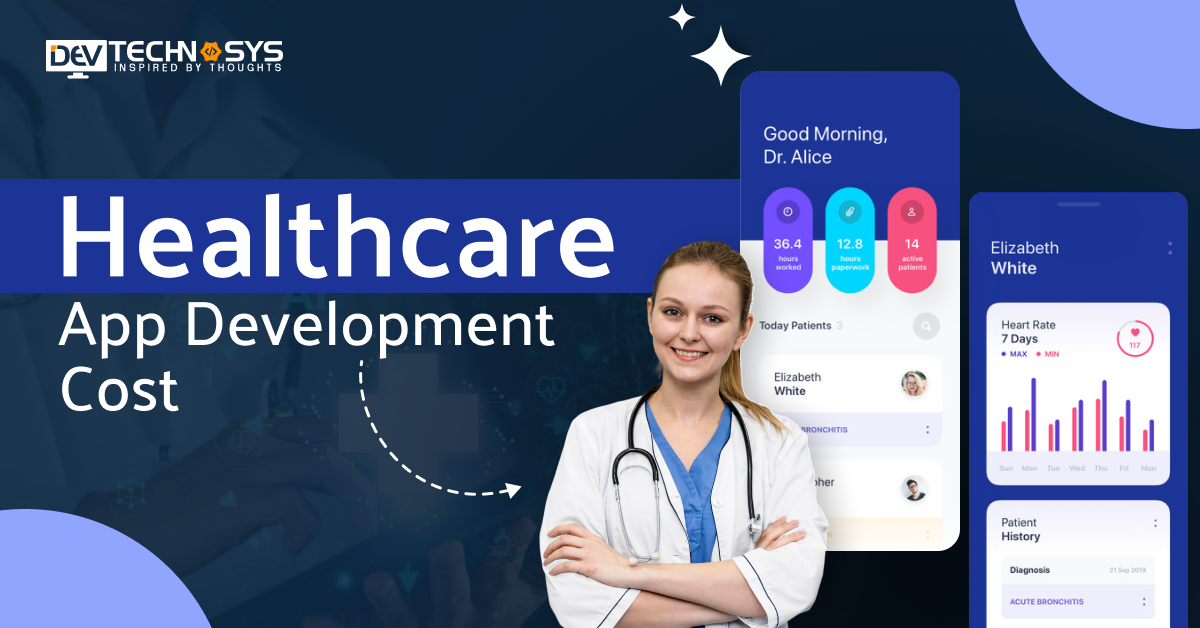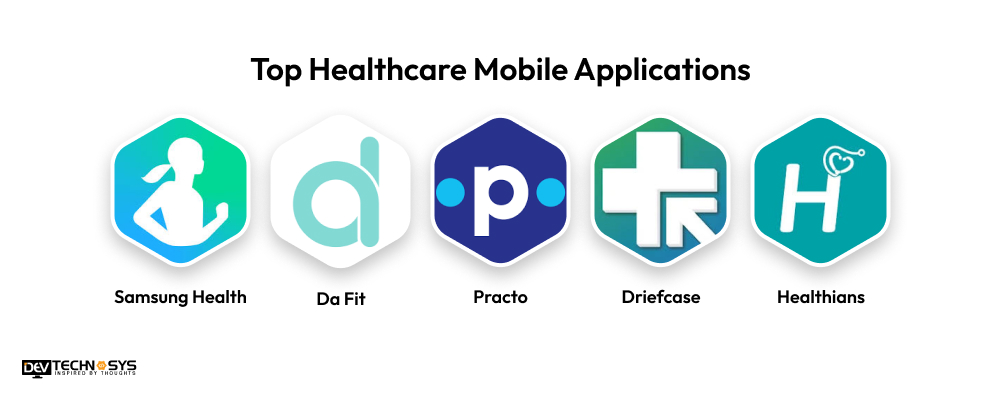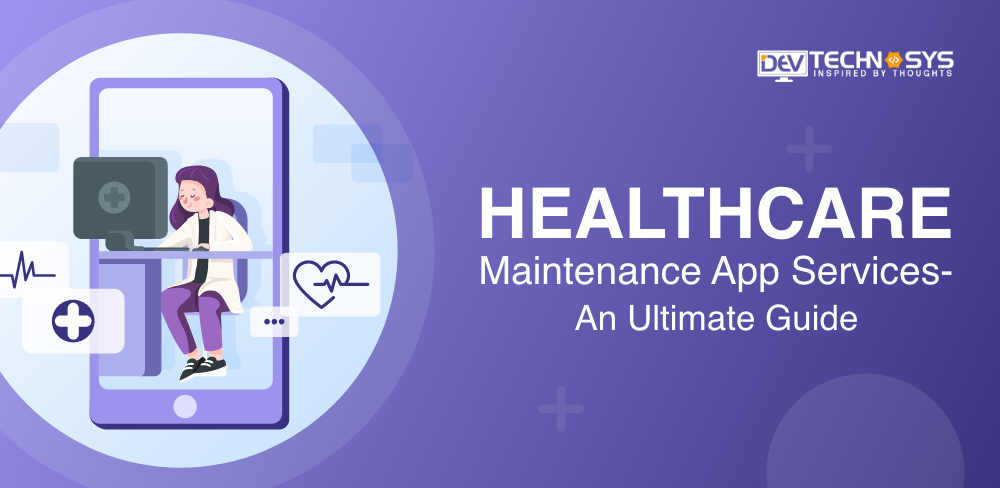The healthcare industry is experiencing a new development in the field of pharmacy, treatment and other healthcare utilities. This has boosted the healthcare app development cost due to the involvement of various resources in the medical sector. The investment in the development of a healthcare mobile app has emerged as a cornerstone in addressing these challenges.
With a growing reliance on medicines and therapies for medical assessments, the demand for sophisticated medical innovations and inventions is emerging and growing rapidly. People involved in the healthcare sector would be a great asset for your business.
Through the development of imperishable technologies in the medical and healthcare industry many business professionals are portraying themselves as key players in this dynamic market. Let’s delve into the key aspects of the development process and explore the potential benefits for enterprises.
Quick Summary: This blog is going to tell you about the working, development steps, benefits, monetization steps along with the cost of development and maintenance in this blog.
What is Healthcare App Development?
As the name suggests, healthcare application development refers to the process of creating a mobile application. The main aim of this application is to provide users with on-demand healthcare services through which they can follow up on their health-related issues in real-time.
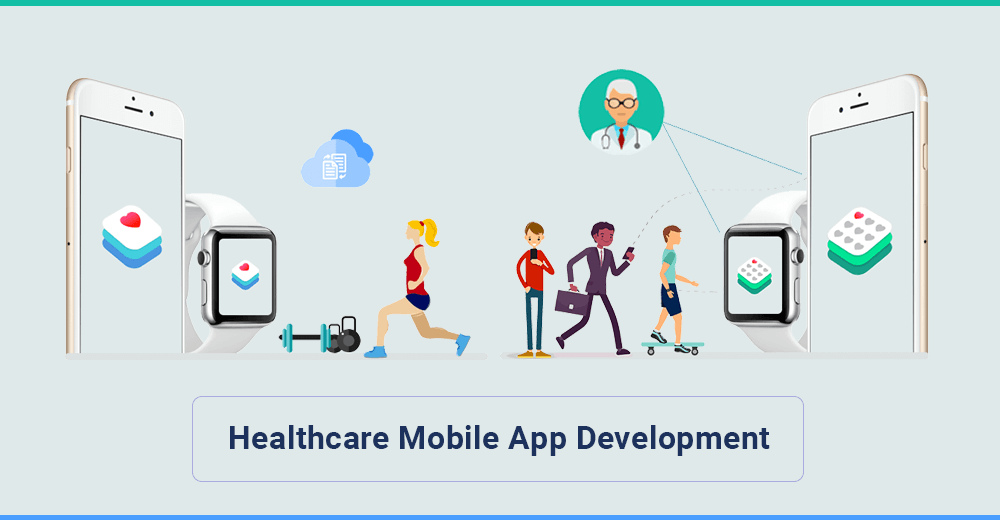
As such, there are a lot of healthcare apps available in the market. And through these apps, people can do/avail the following: services, hospital experience, electronic health records, and insurance claims.
Let’s discuss the main feature of a healthcare mobile app in detail below:
1. For Doctors
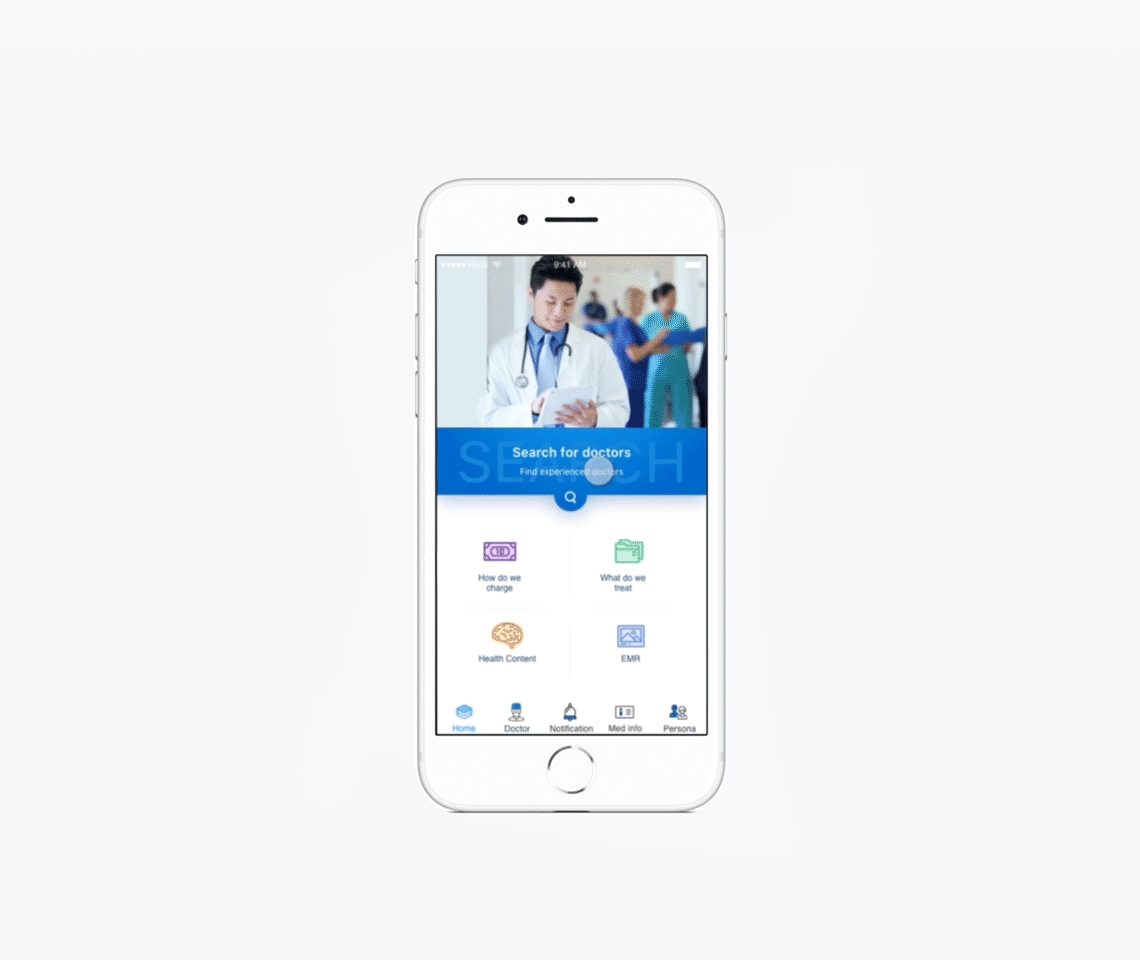
A doctor’s mobile application can help them keep track of their patients along with monitoring, scheduling appointments, as well as staff management. These applications are designed for specific purposes and thus, the same can greatly help healthcare staff in a lot of day-to-day tasks.
2. For Patients
Through a healthcare mobile application, patients can avail many benefits. With it, they can book appointments from their mobile phones, talk to doctors through messaging features in real-time and get recommendations. This is much like fitness app development which also got a push because of lockdown.
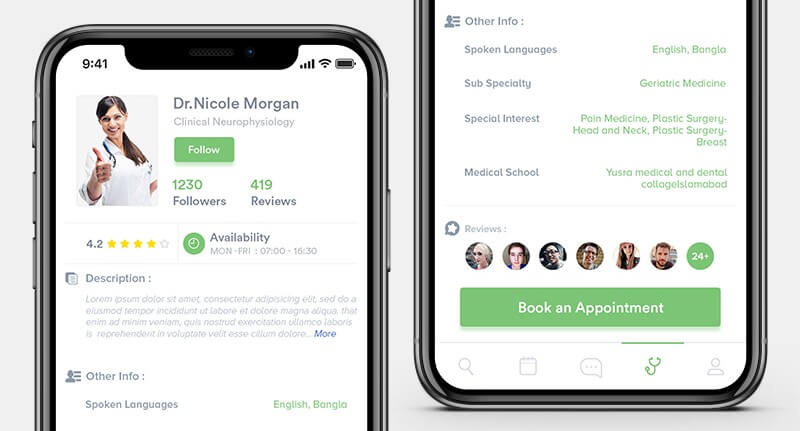
Now, let’s look at some of the stats and facts related to the some:
- In Apple’s app store, there are more than 45,000 healthcare applications.
- On Google Play Store, there are around 43,000 healthcare mobile apps.
- mHealth Market generated more than 13 billion USD across the globe in 2019
- As per the Accenture Survey, 75% acknowledge the importance of healthcare mobile apps.
- The telemedicine market is forecasted to reach 17 billion by 2026
So, all in all, there is a lot of scope in the healthcare industry, and with the help of healthcare app developers, you can create the next big telehealth app in the market. But how do you develop a healthcare app?
How Does A Healthcare App Work?
Knowing the working steps is crucial to manage the healthcare app development cost. We have listed the major working steps of a healthcare mobile app below in this section:-
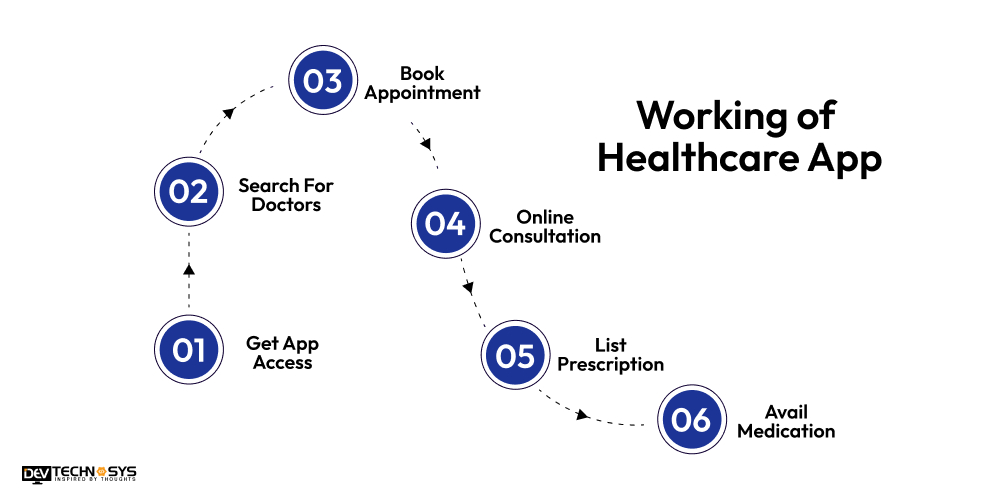
1. Get App Access
Users can access healthcare mobile apps through a simple registration process. Businesses can contact a custom healthcare software development company and invest money to develop a healthcare app with fast and easy app registration and login process to the users.
2. Search For Doctors
Investment in the medical mobile application development process can facilitate users to find their preferred doctors in an easy manner. A mobile app development company would help you in implementing this functionality in your healthcare mobile app for fast searching of doctors.
3. Book Appointment
The next step is that users can book appointments based on their needs and requirements. There are multiple slots available from which they can choose to consult. As a business you must invest money for app development in healthcare so that you can provide fast appointment booking services to users.
4. Online Consultation
After booking a slot for consulting the doctor, users can now interact with the professional experts. They can choose the option for online as well as offline consultation. It is profitable for a business expert like you to develop a mobile app in the healthcare sector to earn high revenue.
5. List Prescription
Now doctors can list prescriptions according to the health condition of the patient. Many healthcare mobile apps provide facilities to record electronic medical data of patients. So, it is important to know EMR/EHR software development cost for businesses to develop a healthcare app.
6. Avail Medication
Lastly, users can order medicines to start the treatment process. Also, they can track their health progress through real time updates. You can invest in custom software development for healthcare to know how much does it cost to develop a healthcare app.
Future Predictions And Projections In Healthcare Industry
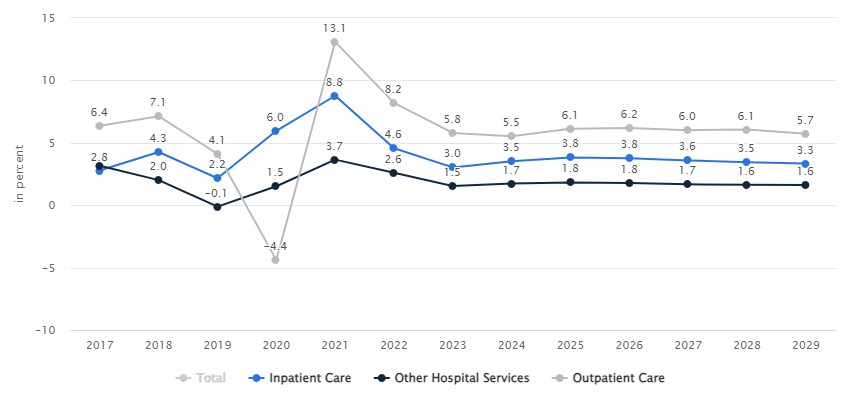
1. Market Trend
The market trend is known as the usage of a particular software or technology in the current time.
- It is predicted that by the end of 2032, the healthcare and medical industry is expected to achieve USD 15.64 Billion. It will maintain a CAGR of 8.1% during 2024-2028.
- The global market of medical imaging services in the healthcare industry is supposed to reach USD 78.30 Billion by 2031. This technology is potentially increasing gradually producing effective and high quality images.
2. Growth Factor
The growth factor is known as the rate of magnification or extension of the market in a particular industry.
- There are multiple units in the medical and healthcare industry who are using AI as a primary technology for building healthcare mobile apps. AI in healthcare is growing at a CAGR of 34.78%, and is projected to produce a revenue of USD 202 Billion by 2036.
- The Blockchain market in healthcare is growing at a CAGR of 15.6% generating a revenue of more than USD 105.3 Billion by the end of 2030. This in turn would result in the increment of employment.
3. Impact on Employability
Employ ability is the most expected attribute in any industry. Its impact may change the route of both the market trend and growth factor.
- In the present scenario we are experiencing a new development in the hiring of the employees in the medical industry than any other sector.
- This will be going to increase in the upcoming time creating a whopping number of more than 14.3 million jobs across the globe.
- According to a report published by Statista, an international forum for world statistics, there were around 11.37 million people who got employment in the United states of America and nearby countries in the past 2 years.
Top 5 Healthcare Mobile Apps
For managing the healthcare app development cost a business investor should know about the trending mobile application in the healthcare sector. There are a lot of different competing mobile apps that are used for healthcare services.
In this section we are listing a table showing the top healthcare mobile applications. They are as follows:-
Top 5 French Healthcare Apps |
Supported Devices |
Downloads |
Ratings |
|
Samsung Health |
Android|iOS |
1B+ |
4.2 |
|
Da Fit |
Android|iOS |
50M+ |
4.3 |
|
Practo |
Android|iOS |
10M+ |
4.5 |
|
Driefcase |
Android|iOS |
5M+ |
4.4 |
|
Healthians |
Android|iOS |
1M+ |
4.5 |
How To Develop A Healthcare App?
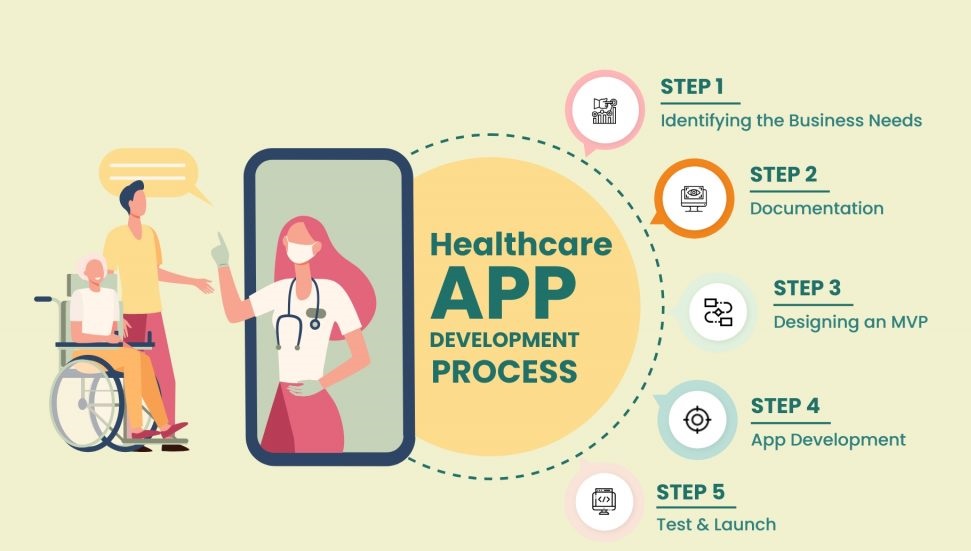
Developing a might seem like a simple process in theory but there is a lot that goes into it. To Develop a Healthcare App, there is an 8-step procedure that you need to follow. Each of these steps or phases of development is important and contributes to the overall functioning of the final product. These steps are, as mentioned below:
- Step1 – Idea Confirmation
- Step2 – Market Audit
- Step3 – Creating App’s Wireframe
- Step4 – Choosing a Platform
- Step5 – Development
- Step6 – Testing and Improvement
- Step7 – Deployment
- Step8 – Post Release work
We shall be discussing all of these eight steps in detail. With this being said, let’s get started with the first step:
Step 1: Idea Confirmation
Assuming that you already have an idea in your app about your healthcare mobile app developers, the first idea is confirmation and cross-check the app. However, if you don’t have an idea, it is recommended to go and find an idea first then we can work on that to turn an idea into a real-world application.
Moving on, to confirm whether or not your idea is fail-proof, you can check the following things:
-
App Objective
Questions the object of the healthcare apps. Do you want to build this app? Does the app go hand in hand with your business? these are a few questions that you can ask yourself and check your idea.
-
Target Audience
Recognizing the target audience is one of the most important things. So, ask yourself who are or can be your potential user.
-
App USP
Features are something that defines your app and drives user engagement. So, what are the important features of this app, and what is the healthcare app’s core appeal?
-
Competitor Analysis
Analyzing competitors is an important part.
-
App Investment
It is important to question whether or not the money you are investing in the app is justified.
If your idea stands its ground and still looks strong, it’s time to move to the next step.
Step 2: Market Audit
Conducting market research or market audit is an important step in healthcare mobile application development. This is the step where you see the real step of the market where you will be perforating later. As such, some of the benefits of the market audit are, as mentioned below:
- Market research helps you understand consumer behavior better.
- It is a great method to get new ideas from the market.
- This is a great method to analyze market opportunities.
- It helps identify the potential market base.
- Through the market audit, you can learn about more features
These are some of the benefits of conducting market research. It is also recommended that you analyze competitors and feedback on their apps. Here, you can see what people hate and like about their apps. Then you can add that to your healthcare apps.
Step 3: Creating App’s Wireframe
When you have an idea and it is backed with market research, it’s time to shape this idea into a wireframe. So, what exactly do we mean by wireframe? Well, you can take it as a sort of blueprint for your application to be built upon.
It will have information regarding the basic design of your application as well as its functionality. In addition, it is will also provide an understanding of the healthcare app’s working and looks. Also, it is the first step where you need to Hire Healthcare App Developers.
The developer will build the healthcare app based on these guidelines known as a wireframe. Thus, we can move to the next step of the healthcare mobile app development process.
Step 4: Platform Choice
Now, the fourth step of healthcare mobile app development is selecting a platform for your mobile application. Now, there are a few different types of platforms you can choose, for instance, native apps, cross-platform ones, and whatnot. Let’s see, each of these in detail:
-
Native App
Native mobile applications are based on either mobile operating systems like Android or iOS. These are built with help of developers’ tools and development languages. You can choose either one of these platforms or both individuals. You can also choose a cross-platform option. Let’s see what it is.
-
Cross-Platform App/ Hybrid App
Cross-platform app development deals with a single mobile app that is built on HTML5. These apps can run on different platforms. In addition to this, they can be downloaded from all app stores just like a native app.
After you a choosing a platform for your application, we can move to the next step.
Interested in a chatbot demo, pricing, or more info? Fill out the form our expert will contact you shortly.
Chatbot Demo
Cost to Develop an app
Industry Report
Case Study
Step 5: Development
Finally, the big step that takes most of the time, is the development of the app. This is where all the heavy lifting is done and your app’s different component is made into one. It is here that it starts taking shape of a real app.
However, before developers start to Develop a Healthcare App, it is required for it to pass a usability test. After that, the app is taken through different parts of development. But before that, it is required to create an appropriate environment for the app and healthcare app developers can start working on the different components of the same.
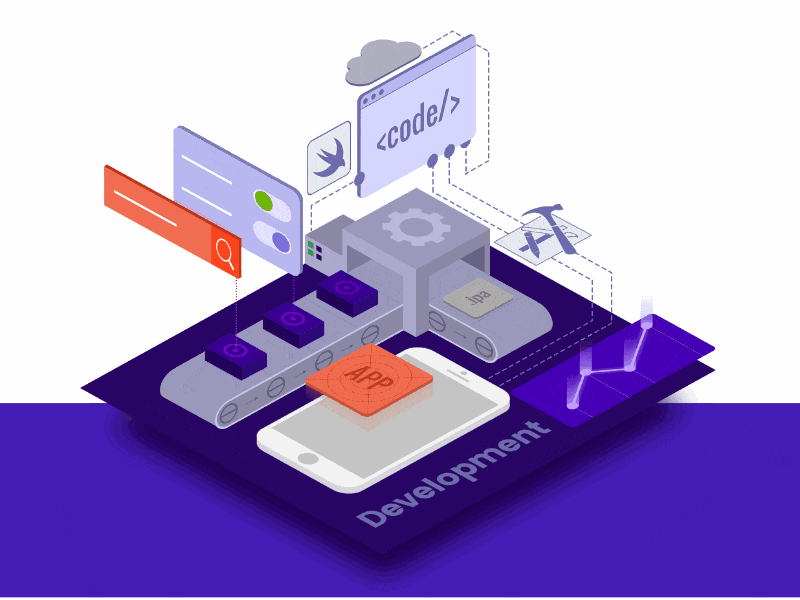
As such, there are three main sections in which, we can divide this phase, these are the following:
- back-end
- APIs
- app front-end
Let’s see what goes on in each of these steps:
-
Back-End/Server Technology
In this part of the development, the database and server-side objects are made imperative for supporting the working of mobile applications. Both of these entities are connected through a network. However, configurations and changes are needed to be done for it to work with the mobile app in the desired method. But this is only applicable if you are using an existing backend platform.
-
Application Programming Interface
APIs or application programming interfaces are sets of practices, tools, or/and protocols that are used to develop software applications. These components are responsible for specifying how the different components of the app interact.
-
Mobile App Front-End
Front-end usually means developing the client side of the app. This is the part of the app that interacts with users. And for that reason, there is a lot that goes into it. For instance, it is here that you have to finalize a UI/UX, color scheming, the functionality of the app, animation, and the behavior of the healthcare application.
When all of these three different components of healthcare application development are done with, we can move to the next and 6th steps.
Read More: EDI in Healthcare Industry
Step 6: Testing and Improvement
React native app development company often advocates the importance of testing mobile applications. And it is only true, testing an application before you launch it into the real world is quite an important step.
So, the application here is deployed into a live environment where it is tested. This step is important to make sure there are no major bugs or errors.
When the testing process is done, the necessary changes are made to the healthcare app, and then it is ready to be deployed into the real market.
Step 7: Deployment
Up until now, we have looked at different steps of development starting from ideation to converting that into real code that into a healthcare app. Now, it is time for launching that application into the Google Play Store, Apple App Store, or both based on the platform you choose.
While this is something you Hire a mobile app developer to do, knowing deploying an app can be beneficial.
Therefore, let’s see how to deploy these apps:
How to Submit Healthcare App In The App Store And Google Play Store?
The highlighting steps to deploy the healthcare app into iOS App Store.
- Make an iOS profile and distribution certificate
- Create an iTunes Connect record for your app
- Upload and archive the healthcare mobile app
- Configure the metadata and other details concerning the app in iTunes Connect Record
- Submit the healthcare app for review
- Check the app status to see whether it is deployed or not
This is the process of deploying an application in the iOS’ App Store. Now, let’s see how do you deploy an app in Google Play Store.
- Get your mobile app information ready
- Upload the APK or mobile app bundle files for your application
- Set your mobile app’s content rating
- Set app’s pricing
- Set a distribution plan
- Publish your application
Step 8: Post Launch Activity
Whether we are talking about healthcare app development or Pharmacy app development, post-release work is absolute. While you might have thought that the app will sustain itself after deploying it, that is wrong.
Mobile application including healthcare application requires regular maintenance work. This doesn’t just involve maintenance but a lot of other work. For instance, this is where you market your apps and pave their way to a potential user base.
This is arguably one of the most important phases of app development. And with this, the whole process of healthcare app development is done.
Core Features of a Healthcare Mobile Application
Features are an important part of Healthcare or Doctor Appointment App Development. After all, features are the backbone of mobile applications and it is through features that people judge an application. Now, this is one of the reasons why you need your app to be filled with all the right features.
In this section of the blog, we shall be looking at the core features of a healthcare mobile application. With this being said, let’s get started:
1. EMR/EHR
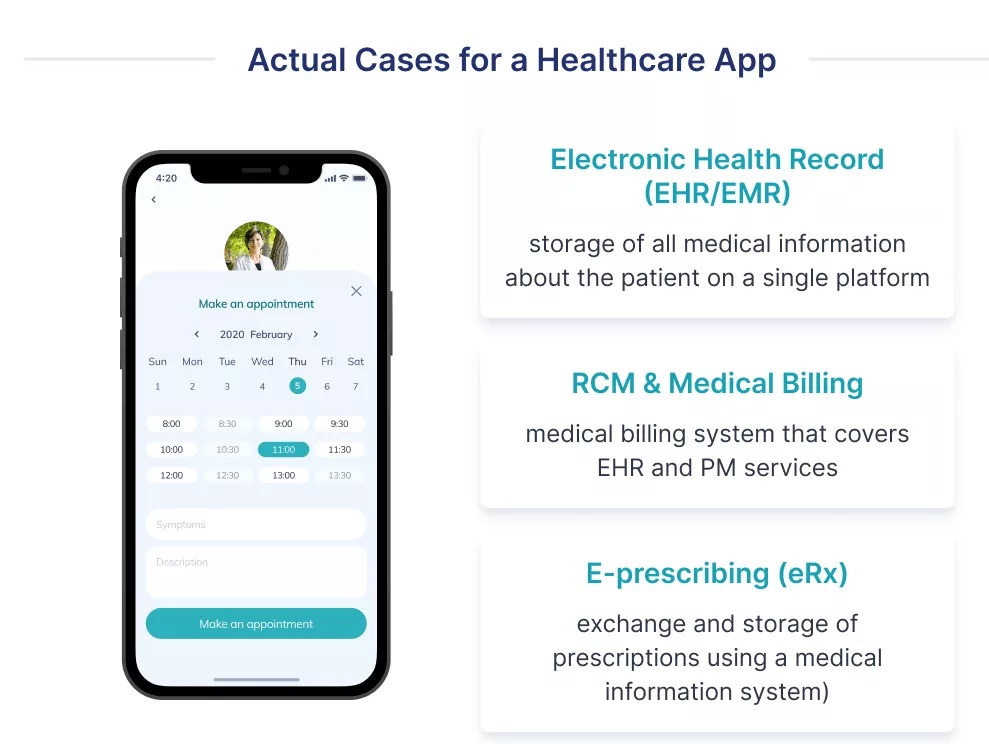
EMR/EHR is considered to be the driving force behind a healthcare mobile app as well as the cost of development. EMR and EHR stand for Electronic Medical Records and Electronic Health Records respectively. These modules enable a centralized system that helps in better management of patients’ data and records.
2. Medical Workflow Automation
MWA is considered to be an ancillary module to EHR. This involves medication accidents, as well as incident tracking. In addition to that, it also information to medical staff about the drug dosage, timing fluid replenishment timings, and drug and waste management of patients.
3. Doctor and Patient Communication
This feature enables real-time interaction between patients and doctors. In addition to this, it also contributes to scheduling appointments, tracking visits, etc.
4. Video Conferencing

Much like other video conferencing features, this feature enables face-to-face interaction through a video feed using the camera of the Smartphone.
5. Payment Processing
In the NFC app payment processing system is a plus point for both doctors and patients alike. This allows them to directly pay the doctors or medical staff for the exchange of healthcare services and products.
6. Shopping Cart
This module works with patients and customers in a committed eCommerce area where they can purchase medications and medical care items straightforwardly from the application.
7. Third-Party API Integration
This component includes the reconciliation of outsider administrations and applications utilizing recorded APIs like Google Maps API.
8. Custom API For Website Interoperability
This progression includes the advancement of a custom API to associate the portable application to a current site for permitting the trading of information between the two frameworks.
9. Content Management System
Integration of a Content Management System works with heads to effectively change the substance of the application.
10. Reporting and Analytics
Integration of Analytics to get customary reports on application conduct, application issues, network bottlenecks, and application crashes.

11. Custom UI Design
An expertly planned extraordinary UI with tweaked parts and page formats complying with Human Interface Guidelines for iOS and Material Design for Android.
12. User Profiles
Allowing clients to modify profiles, with data that may be public.
13. Email and Password Login
Allowing clients to make profiles utilizing an email id and a custom secret phrase.
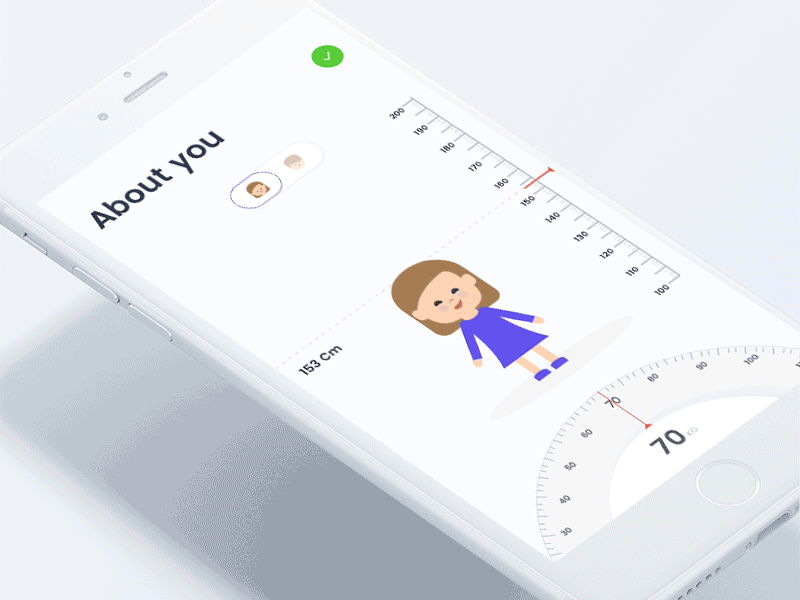
14. Social Login
Allowing clients to sign in and join the application by utilizing interpersonal organizations, for example, Facebook, Twitter, Google Plus, LinkedIn, and so on.
15. Two-Factor Authentication and SSL Encryption
Incorporation of very secure confirmation strategies which are accessible just to the client.
16. Wearable Device Connection
Connect the application with Wearable Devices so the clients can undoubtedly track or screen their exercises easily.
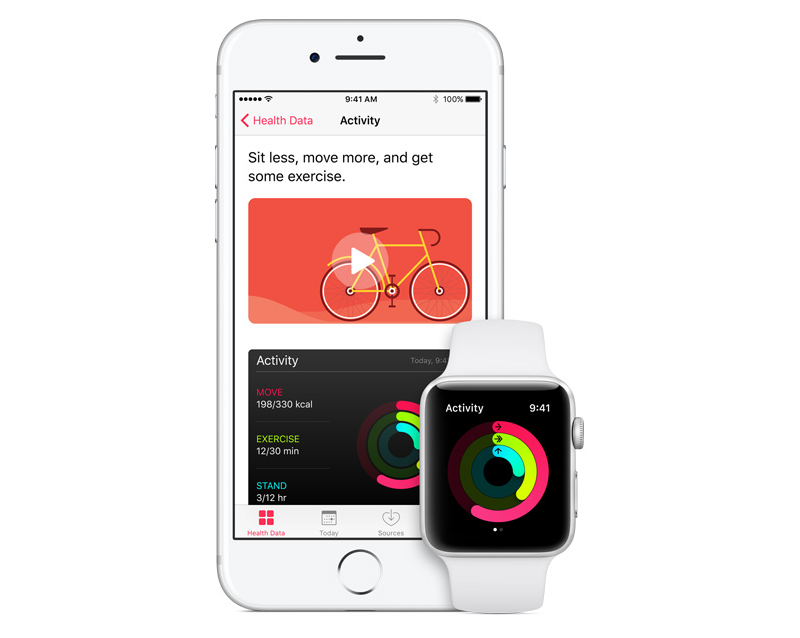
17. Push Notifications
The joining of message pop-up usefulness to remind the patient or customer about the normal exercise or measurements of drugs, even when the client isn’t utilizing the application.
18. User Dashboard
This component includes the making of a page which shows structures, outlines, and other customized data.
19. Activity Feed
A flood of action from the client is generally requested consecutively or sequentially.
20. Search
The joining of a Custom Search Box with search auto-fulfillment and ideas.
So, these are some of the basic features that you should consider if you want to develop a Healthcare App. With this being said, there is another major concern that remains and we are talking about the cost of developing a healthcare app. We shall be looking at this in the next section of the blog.
How Healthcare App Development Benefits Businesses?
Development benefits encourage businesses to reduce the healthcare app development cost. Here are the important benefits that a business investor must know for healthcare mobile app development:-

1. Public Exposure
A healthcare mobile app like Practo is very much popular among the users from all over the world. This allows users to come on the healthcare application for multiple services in a huge number. The Healthcare industry is a place for such mobile applications with extensive user engagement.
2. Innovative Industry
The medical sector is advanced and inventive that help businesses to build a healthcare app for their users. It is useful for business investors to contact a healthcare app development company with an innovative mindset. This will benefit your business to have a leading edge on other professionals.
3. Official Agreement
Healthcare is a very popular industry among the people which get official assistance and funds in order to manage the cost to build a healthcare app. The funding structure is different for healthcare website development cost management which could be less based on complexity level.
4. Easy Investment
Money investment is very easy in the healthcare sector as it is common and significant. There are multiple services which are beneficial for both businesses and users like Electronic Medical Record (EMR). It would be a good move for investors to invest in EMR mobile app development in healthcare.
5. Consistency
The healthcare sector is consistent enough for many businesses to grow and supervise their mobile app development. Using chatbots in healthcare could also help them to boost their industrial strength. They must know about the past developments in healthcare to modify new resources for persistent growth.
What Are Methods To Earn Money From A Healthcare App?
Monetization is a mandatory process to run a professional business by managing the healthcare app development cost. This section describes the major money making strategies:-
1. Consultation Charges
The first business model to earn money through mental EHR software development is applying charges on doctor consultations. This can gradually help your business to sustain in the tough healthcare market. This step is helpful for initial growth and revenue generation.
2. Extra Services
You can run extra services like lab tests, treatment diagnosis, and medical scanning to start earning and manage the healthcare app development cost. Users can avail all these facilities on mobile as well. Investment in the mhealth app development is required to earn from these services.
3. Delivery Fees
Next monetization model is applying fee structure on medicine delivery services. First you must avail healthcare app development services to know about how to develop a healthcare app. Then you can ask your developers to enrich your mobile app with a delivery model for generating income.
4. Policy Funding
You can use blockchain in the healthcare industry which could assist your healthcare business to earn through medical insurances and policies. This is a very effective method for business investors as it allows high flow of revenue for the healthcare industry professionals.
Why Budget Fixing Is Important And How To Do It?
Budget management is necessary from a business point of view because it helps business investors in reducing the healthcare app development cost. Let us put some light on the primary budget fixing methods:-
1. Strict Observation
Why:- Observing market trends is very important to know about top trending healthcare applications for app development.
How:- You can make a research team for this task and ask them to gather detailed information from development to cost.
2. Develop A Model
Why:- Making a model before app development is crucial to reduce the cost to develop a healthcare app.
How:- You can hire healthcare app developers for prototype building to list features and tools for creating the original healthcare mobile app.
3. Manage Time
Why:- Time management is very crucial for business investors in order to manage the healthcare mobile app development cost.
How:- Along with investment in healthcare mobile app development you can ask development partners to create a timeline for app building and stick to it.
4. Do Extra Saving
Why:- Saving for app maintenance and security is mandatory for business investors to increase healthcare mobile app efficiency and longevity.
How:- First you should find a healthcare app development company in the USA. Then, discuss this issue with them for effective budget management.
What Is The Healthcare App Development Cost?
Investing in mobile app development for building a healthcare application can be a strategic move for social care businesses. However, understanding the current market healthcare app development cost of developing such applications and staying ahead of industry trends is crucial to maximizing the potential.
The healthcare industry is renowned for its high development costs. Even basic mobile application development with limited features can require a substantial investment, typically ranging from $8,000 to $15,000.
Developing a complex, innovative healthcare mobile app can be significantly more costly, often exceeding $26,000. To accurately determine the mobile app development cost for your specific project, consulting with an android app development company is recommended.
Application Structure |
Development Time |
Estimated Cost |
|
Simple App |
5-8 months |
$8000-$15000 |
|
Moderate App |
8-12 months |
$15000-$21000 |
|
Complex App |
More than 12 months |
$21000-$26000 |
Read More: Patient Portals For Healthcare
Factors That Can Affect The cost of healthcare Application Development
So, this is the basic cost of developing an application. Now let’s look at the factors which can affect the final price. These are, as mentioned below:
1. Location
The location of the developer can affect the price of development. As the development companies based in the United States of America charge more than a company that is based in an Asian country like India. So naturally, this is one of the largest factors that affect the cost of healthcare app development.
2. Complexity
A more complex application takes a longer time to develop along with more effort. That is why as the complexity of the application increases, the price increases with it. Several things contribute to it:
- Features
- UI/UX
- App Size
3. Mode of Service
As things stand there are multiple methods to hire an Android app development company. These are, as mentioned below:
- Local App development company
- Assembling an in-house team of developer
- Hiring a freelancer
- Hiring an outsourcing Company
How Maintenance & Updates Help Healthcare Apps To Perform Well?
The healthcare app development cost is dependent upon multiple factors like interface designing, integration of APIs, security, and app maintenance with regular updates. Maintaining a mobile app is very crucial after the app development as it resolves issues related to technical glitches and app vulnerabilities.
The healthcare mobile app maintenance cost is normally calculated as 15-20% of the total app development cost. If a business invested $20000 in healthcare app maintenance services to build a healthcare app then $3000-$4000 will be the cost of maintenance.
Gather Your Assets For Healthcare App Development!!
If you are in the healthcare business and you want to capitalize your strength then it is important for you to know the healthcare app development cost. This is the primary thing that can make half your job done before starting the healthcare app development process. Your main target should be gathering development resources that are necessary for healthcare mobile app building.
To guard your healthcare business you can contact an on demand app development company with reliable and scholastic app development services. You must make this situation suitable for your business growth and generate revenue to sustain in the industrial market. So, don’t let your efforts go in vain and contact us to avail competent app development services.
Frequently Asked Questions
1. Why Time Management Is Important For Healthcare App Development?
- It helps business investors to prioritize app development steps.
- Gives time in the app launching process.
- Can spare time for some other important tasks.
- Helps in cost reduction and managing extra expenses.
2. How Much Healthcare App Development Cost Is Required?
- The usual app development cost is around $8000-$14000.
- Above cost is for a simple and less compatible healthcare mobile app.
- An increase in the app building cost may be experienced due to added features.
- It can go up to $26000 or more depending on complexity level.
3. Why App Maintenance Is Important?
- This process makes the mobile app smooth and efficient for use.
- Provide reliable security checks to the users.
- Allow regular updates to facilitate productivity to your mobile app.
- Lessen the business effort for improvisation.
4. How Businesses Benefit From Healthcare App Development?
- Access to large user data to enhance their mental and physical health.
- Huge investment by different business experts.
- Government supported and economically aided.
- Persistent market growth with remarkable profit.
5. What Are The Monetization Steps To Earn From Healthcare Apps?
- As a business you can charge extra on consultations.
- Take royalty on delivering medicines to the users.
- Implement other services like lab tests to generate extra revenue.
- Employ policy and insurance model to charge fees on claims.
6. How To Market A Healthcare App?
- Provide free services to the users initially.
- Implement advertising supported models to market effectively.
- Hire brand ambassadors to get a good recognition of your mobile app.
- Allow users to share feedback on the app facilities.
7. What Services Dev Technosys Provide To Reduce Healthcare App Development Cost?
- We provide affordable mobile app development services.
- Our mobile app development team is competent and talented.
- Readily available for customer support with technical assistance.
- Allow business investors to put requirements according to their preferences.
